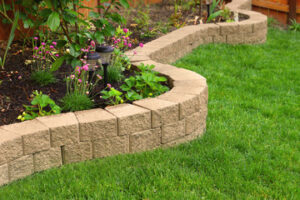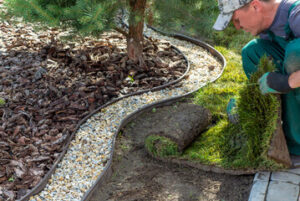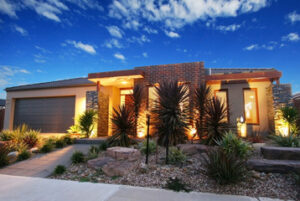Many homeowners wish to harmonize their house and yard aesthetically, while others want sustainable landscaping that conserves water. To do so, you need a functional plan.

Start by studying designs that appeal to you in books and magazines. Note how each element is linked to create unity and interconnection. For professional help, you can contact Landscaping Baltimore.
Lines in landscape design are important for defining areas, creating movement and establishing a sense of balance. They can be straight, curved, horizontal, or vertical and come in many forms, including borders of plants, hardscapes, and walkways. They can also be even or uneven.
Straight lines accentuate the structure of a landscape and give it a more formal crispness. They can frame views we want to see and hide those we don’t, and they direct where people look and where they go. They can also make a garden seem larger or smaller than it actually is.
Curved lines mimic nature and evoke a more relaxed, informal feeling. They move the eye more slowly than straight lines and can create a feeling of mystery by suggesting that something interesting is around the next bend. They work well for paths, plant bed lines, and dry stream beds.
Vertical lines evoke strength and stability, and they are often used to accentuate large spaces or to draw the eye upward. They can be created with a variety of hardscapes, including tall trees, pillars, and statues, or with softscapes, such as narrow tall grasses and shrubs.
Form is closely linked to lines in the landscape and plays a role in developing the overall feel of your space. Groupings of plants can be used to develop symmetry, and hardscapes such as fences, walls, and pathways can help create visual unity through repetition and the Rule of Three. Simple repetition, such as lining up three identical plant pots in a row, helps create cohesion and visual harmony. It’s important to use repetition sparingly, however, because too much can lead to a cluttered, confusing landscape.
Color
Color in your landscape is a crucial element that can transform the design. It can create focal points, enhance space and perspective, establish harmony, embrace seasonal transitions, and more. The use of color is also a great way to express yourself and your personal style through your garden.
Choosing colors for your landscaping can be overwhelming, especially if you are not familiar with color theory. However, understanding some basics can help you choose colors that complement each other and bring balance to your landscape.
There are two main categories of colors: primary and secondary. The primary colors are blue, red, and yellow. The secondary colors are orange, purple, and green. The tertiary colors are created by mixing the primary and secondary colors. For example, red and yellow mixed together make orange. There are also tints and shades of colors. A tint is a light version of the color while a shade is darker than the original color.
When planning your landscape, it is important to consider the colors of buildings, structures, and other hardscape elements. You can blend these colors into your landscape or contrast them for visual interest. It is also important to consider the climate and geographic location of your garden when selecting colors for your landscape.
Another important aspect of color is intensity. A bright color has a strong impact while a dull color is less noticeable. Intensity is also important when combining flowers. For example, pairing a vibrant rose with a delicate pastel lavender can add an eye-catching contrast.
If you’re unsure where to start, consult with a professional landscape designer. They can guide you through the process of creating a harmonious and appealing landscape with your own unique color scheme.
Texture
The importance of texture in landscaping is often overlooked. It adds depth, interest and a sensory dimension to your landscape. It also helps define the space and evokes the imagination of your guests. In addition, it ties your landscape to the surrounding environment and creates a harmonious coexistence with it.
Texture refers to the visual and tactile quality of plant surfaces, including the coarseness or fineness of their leaves and their density. It also affects how light and shadow interact with a garden’s plants. The more contrasting the textures, the more interesting and engaging your landscape will be. In general, coarse textures appear more dramatic and formal while a massing of fine textures tends to be softer and more casual.
Another important factor in landscaping is the use of color. While it is less obvious than lines and form, it is equally important and can make a huge difference in the final result. Warm colors such as reds and oranges have a tendency to advance towards the viewer, while cool tones like blues and violets recede into the background.
Lines are a crucial aspect of landscape design, as they provide the natural pathways for the eye to follow. They can be actual (real) or perceived, and they may be vertical, horizontal or curvilinear. The placement of your plants should be based on the lines in your garden, which will determine their shape and size.
A well-designed landscape can improve your home’s curb appeal and increase its value. It can also help reduce stress and anxiety by providing a place where you can relax. It can also encourage physical activity and provide a sense of community with your neighbors. In addition, the right landscaping can also provide environmental benefits, such as reducing erosion and improving air quality.
Form
Landscape design is a problem-solving process that incorporates horticultural science and artistic composition. It uses elements (visual qualities) like line, form, texture, color, and visual weight and principles (guidelines) like proportion, order, repetition, and unity of design to create spaces and connect them in a meaningful way.
For example, lines can be structural and forceful or more natural and flowing. Straight lines create a formal character and are associated with symmetrical balance, while curvilinear lines are more organic in character and lead the eye to a focal point. Focal points are also important to consider when creating your garden design, whether it’s a large water feature, a flower garden, or a paved seating area. These focal points catch the eye and can help guide movement around your property.
Form refers to the shape of an object, such as a plant or tree. It can be structural, as in the symmetrical, upright branches of a Lombardy poplar, or flowing, as in the drooping branching pattern of a weeping willow. Using a mixture of these forms gives your landscape a sense of balance and harmony.
Hardscapes are non-organic materials, such as paved areas and fences, that are incorporated into the landscape. They can be linear, square, or curved in form and used to connect different parts of the landscape or to emphasize focal points. Curved shapes are particularly effective because they can be molded into arcs and ovals, which move the eye in a more subtle and graceful way than straight lines. In addition, curves can be combined with lines to create a more complex form theme.
Interconnection
In landscape design, the connections between different elements are important. They can create natural transitions, dramatic lines, focal points and unity. They can also highlight specific textures, colors and shapes of the landscape. For example, a waterfall in a mountain setting can enhance the visual appeal of the surrounding vegetation by creating a contrast between water and rocks. In addition, hardscaping can be used to solve problems in the landscape, such as preventing erosion or improving drainage.
Proportion: The sizing of landscaping components should be in proportion to the overall size of the landscape. Elements that are too large will overwhelm the space and not add any value to it, while those that are too small will have little impact.
Order: The arrangement of landscape elements should be organized in a way that is visually appealing and easy to maintain. This can be accomplished by using a variety of techniques, such as scale, repetition, and contrast.
Sequence: Creating smooth transitions in the height, size, shape and color of plant materials. Abrupt changes in these elements usually look unnatural and should be avoided. For example, a sudden transition from tall plants to short ones or from fine-textured flowers to rough ones should be avoided.
Focalization: Creating a point of interest that draws the eye. This can be done by incorporating a statue, a water feature or a focal tree. Moreover, it is important to keep in mind that the landscape should complement the architecture of your home. Using the same architectural style on your hardscaping and softscaping will make your landscape feel more cohesive and connected. You can also use curved lines in your design to create movement and draw the eyes.

